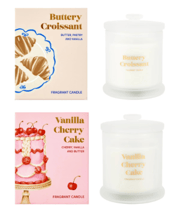Dietitian reveals the top supermarket choices and her ultimate favourites!
- Replies 14
Gone are the days when bread was merely a staple, a simple white loaf to accompany every meal. Today, the bread aisle in supermarkets is a labyrinth of choices, with labels boasting grain, seed, protein, low-carb, high-fibre, low-GI, gluten-free, low-FODMAP, rye, and sourdough options.
It's enough to make anyone's head spin, especially for those of us who grew up when bread choices were straightforward.
Dietician Susie Burrell shared her rankings for the top supermarket breads today based on their nutritional factors.
Despite the variety, it's interesting to note that in Australia, white bread still tops the sales charts.
This preference indicates a gap between the breads we're drawn to and the ones that are better for our health.
As we age, making informed choices about our diet becomes increasingly important, and bread is no exception.

The nutritional high-flyers
When it comes to bread, not all slices are created equal.
The best options from a nutritional standpoint are dense grain breads with a wholemeal flour base.
These breads are not just a source of complex carbohydrates; they're packed with dietary fibre, vitamins B and E, and essential micronutrients.
The whole grains contribute to a lower glycaemic index (GI), which means they help maintain stable blood glucose levels, an essential factor in preventing diabetes and managing weight.
Understanding glycaemic control
Bread is a staple in many diets, often consumed daily.
The GI of bread plays a crucial role in our health because it affects blood glucose control.
High-GI loaves, such as white bread and some wholemeal varieties, can spike blood sugar levels, which is particularly concerning for those with diabetes or pre-diabetes.
In contrast, dense grain-based breads with a lower GI are more conducive to maintaining a healthy blood sugar balance.
Choosing the right slice
For whole grain enthusiasts, the ideal choice is a small, wholegrain bread that provides 20-30g of carbs per two slices. If you prefer denser bread, you might only need one slice to feel satisfied.
For those who can't or don't want to eat grains, wholemeal or rye bread is the next best option.
Even if you're a die-hard white bread fan, it's worth considering a switch to wholegrain for its health benefits.
Be cautious with supermarket sourdough, as it may not offer the same benefits as artisanal loaves, particularly if made with white flour.
The dietitian's picks
Let's break down Susie Burrell's rankings and see which loaves come out on top:
1. Wonder Wholemeal Sandwich with Iron: A great alternative for those who can't tolerate grain-based bread, offering the benefits of whole grains without the grains themselves.
2. Tip Top The One Soft Wholemeal Sandwich: A solid choice nutritionally, this bread could improve the digestive health of Australians if it replaced high-fibre white breads.
3. Helga’s Traditional Wholemeal: This bread meets the daily recommended wholegrain intake for adults in just two slices, though its larger size means a higher carbohydrate and calorie count.
4. Helga’s Mixed Grain: With a 17% mixed-grain base, this bread aids in blood glucose control, though it has a larger slice size and lower overall grain content.
5. Abbott’s Bakery Light Rye: Lighter than some rye options, this bread is suitable for those with sensitive stomachs, though it has a higher carbohydrate content and less dietary fibre.
6. Wonder White Sandwich Vitamins and Minerals: Enriched with dietary fibre and essential nutrients, this bread is still outshone by its wholemeal counterpart.
7. Tip Top The One Soft White Sandwich: This white bread has an improved nutritional profile with added dietary fibre, but it can't compete with wholegrain sources.
8. Coles White Sandwich Loaf: Budget-friendly but nutritionally lacking, this plain white loaf is high GI and low in dietary fibre.
Susie Burrell also listed her favourite loaves of bread.
Burgen Soy-Lin: Formulated with women's nutritional needs in mind, this bread is perfect for weight control and provides a good source of omega-3s.
Bakers Delight Cape Seed Loaf: Packed with seeds and wholemeal flour, this loaf is high in dietary fibre, protein, and healthy fats.
Helga’s 50% Lower Carb 5 Seeds: Ideal for those managing their weight or blood sugar, this loaf is high in dietary fibre and low in carbs.
Tip Top 9 Grain Wholemeal Sandwich: A well-rounded bread that's soft enough for sandwiches and high in whole grains.
Wonder White Smooth Wholegrain: A good option when grains aren't suitable, this loaf still offers a decent wholegrain content and dietary fibre.
Coles Bakery High Fibre Low GI 7 Seeds and Grains: One of the best options nutritionally and price-wise, this bread is high in dietary fibre and seeds.
In the quest for healthier eating habits, understanding the nutritional content of staple foods like bread is crucial.
Susie Burrell’s analysis shed light on the varying nutritional profiles of supermarket bread, offering valuable insights into making informed dietary choices.
As we delve into the nuances of bread selection, it's also essential to consider broader dietary concepts, such as the significance of carbohydrates and their impact on overall health.
By exploring the distinction between ‘naked carbs’ and ‘net carbs’, we can gain a deeper understanding of how different types of carbohydrates affect our bodies.
Let's unravel the complexities of carbohydrate consumption and its implications for dietary planning.

What are your go-to bread choices, and how do you incorporate them into a healthy diet? Share your thoughts and experiences in the comments below!
It's enough to make anyone's head spin, especially for those of us who grew up when bread choices were straightforward.
Dietician Susie Burrell shared her rankings for the top supermarket breads today based on their nutritional factors.
Despite the variety, it's interesting to note that in Australia, white bread still tops the sales charts.
This preference indicates a gap between the breads we're drawn to and the ones that are better for our health.
As we age, making informed choices about our diet becomes increasingly important, and bread is no exception.

Susie Burrell ranked 8 popular supermarket breads and revealed her favourites. Credits: Shutterstock
The nutritional high-flyers
When it comes to bread, not all slices are created equal.
The best options from a nutritional standpoint are dense grain breads with a wholemeal flour base.
These breads are not just a source of complex carbohydrates; they're packed with dietary fibre, vitamins B and E, and essential micronutrients.
The whole grains contribute to a lower glycaemic index (GI), which means they help maintain stable blood glucose levels, an essential factor in preventing diabetes and managing weight.
Understanding glycaemic control
Bread is a staple in many diets, often consumed daily.
The GI of bread plays a crucial role in our health because it affects blood glucose control.
High-GI loaves, such as white bread and some wholemeal varieties, can spike blood sugar levels, which is particularly concerning for those with diabetes or pre-diabetes.
In contrast, dense grain-based breads with a lower GI are more conducive to maintaining a healthy blood sugar balance.
Choosing the right slice
For whole grain enthusiasts, the ideal choice is a small, wholegrain bread that provides 20-30g of carbs per two slices. If you prefer denser bread, you might only need one slice to feel satisfied.
For those who can't or don't want to eat grains, wholemeal or rye bread is the next best option.
Even if you're a die-hard white bread fan, it's worth considering a switch to wholegrain for its health benefits.
Be cautious with supermarket sourdough, as it may not offer the same benefits as artisanal loaves, particularly if made with white flour.
The dietitian's picks
Let's break down Susie Burrell's rankings and see which loaves come out on top:
1. Wonder Wholemeal Sandwich with Iron: A great alternative for those who can't tolerate grain-based bread, offering the benefits of whole grains without the grains themselves.
2. Tip Top The One Soft Wholemeal Sandwich: A solid choice nutritionally, this bread could improve the digestive health of Australians if it replaced high-fibre white breads.
3. Helga’s Traditional Wholemeal: This bread meets the daily recommended wholegrain intake for adults in just two slices, though its larger size means a higher carbohydrate and calorie count.
4. Helga’s Mixed Grain: With a 17% mixed-grain base, this bread aids in blood glucose control, though it has a larger slice size and lower overall grain content.
5. Abbott’s Bakery Light Rye: Lighter than some rye options, this bread is suitable for those with sensitive stomachs, though it has a higher carbohydrate content and less dietary fibre.
6. Wonder White Sandwich Vitamins and Minerals: Enriched with dietary fibre and essential nutrients, this bread is still outshone by its wholemeal counterpart.
7. Tip Top The One Soft White Sandwich: This white bread has an improved nutritional profile with added dietary fibre, but it can't compete with wholegrain sources.
8. Coles White Sandwich Loaf: Budget-friendly but nutritionally lacking, this plain white loaf is high GI and low in dietary fibre.
Susie Burrell also listed her favourite loaves of bread.
Burgen Soy-Lin: Formulated with women's nutritional needs in mind, this bread is perfect for weight control and provides a good source of omega-3s.
Bakers Delight Cape Seed Loaf: Packed with seeds and wholemeal flour, this loaf is high in dietary fibre, protein, and healthy fats.
Helga’s 50% Lower Carb 5 Seeds: Ideal for those managing their weight or blood sugar, this loaf is high in dietary fibre and low in carbs.
Tip Top 9 Grain Wholemeal Sandwich: A well-rounded bread that's soft enough for sandwiches and high in whole grains.
Wonder White Smooth Wholegrain: A good option when grains aren't suitable, this loaf still offers a decent wholegrain content and dietary fibre.
Coles Bakery High Fibre Low GI 7 Seeds and Grains: One of the best options nutritionally and price-wise, this bread is high in dietary fibre and seeds.
In the quest for healthier eating habits, understanding the nutritional content of staple foods like bread is crucial.
Susie Burrell’s analysis shed light on the varying nutritional profiles of supermarket bread, offering valuable insights into making informed dietary choices.
As we delve into the nuances of bread selection, it's also essential to consider broader dietary concepts, such as the significance of carbohydrates and their impact on overall health.
By exploring the distinction between ‘naked carbs’ and ‘net carbs’, we can gain a deeper understanding of how different types of carbohydrates affect our bodies.
Let's unravel the complexities of carbohydrate consumption and its implications for dietary planning.
Key Takeaways
- The highest nutritional quality breads are dense grain breads based on wholemeal flour, offering numerous health benefits including improved blood glucose control.
- Wholegrain and dense grain-based options are superior choices over more processed white bread, even those labelled as low-GI, due to their lower glycaemic load.
- Susie Burrell ranked the top 8 supermarket bread and shared some of her favourites.
- Bread choices like wholemeal, grain-based, lower carb, and rye are recommended over plain white bread for better dietary fibre intake, micronutrient availability, and overall health.
- Speciality breads such as Burgen Soy-Lin, Bakers Delight Cape Seed Loaf, and Coles Bakery High Fibre Low GI 7 Seeds and Grains are highlighted for their specific health benefits, including high dietary fibre, protein, and omega-3 fatty acid content.
Last edited:







